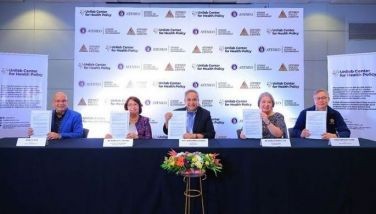What’s in a surname?
May 7, 2006 | 12:00am
Narciso Claveria y Zaldua, governor and captain general in the Philippines from 1844 to 1849, had a great love for order, which explains why he promulgated a decree for the adoption of surnames for all Filipinos. In his travel to the different provinces, this native of Gerona, Spain noticed that the colonial Philippines’ native residents lacked individual surnames to distinguish families.
Some indigenous surnames were Karunungan, Karamihan, and Kahabagan in Laguna, the Kapampangans were Makapagal, Gatpolintan, and Gatmaitan, and in Batangas the Dimayugas, Dimagibas, Dimatulac, and Dimalantas. Many had adopted the names of saints that resulted in the existence of thousands of individuals having the same surname.
Claveria therefore issued a superior decree for Filipinos to take possession of surnames from a catalogue compiled by the Reverend Father Provincials of the religious orders that totaled five: the Jesuits, Franciscans, Agustinians, Dominicans and Recollects.
The Jesuits were in charge of Surigao, Davao, and Cotabato. The Franciscans were in Laguna, Quezon, Aurora, Samar, Leyte, and portions of Bulacan. The Agustinians took charge of the provinces of Batangas, Pampanga, Iloilo, Cebu, Ilocos, Capiz, Antique, and Aklan. The Dominicans of Batanes, Cagayan, Pangasinan, Tarlac, Bataan, and Zambales, and the Recollects Bohol, Cavite, Siquijor, and Dumaguete. This book of names came to be known as Catalogo de Alfabetico de Apellidos. The surnames offered were plentiful – 60,638 – which gives you an idea of the population of the Philippines in 1849. For example, suggested surnames included Horada, Hore, Horeda, Horio, Horiona, Hormachigos, Hormaoche, Hormachea, Hormasedo, Hormes, Hormasada, Hormasuela, Hormigos, Hormigosa, Hormiguer, Hormiguera, Hormillas, Hormillada, Hormilleja, Horna, Hornachos, Hornacholos, Hornada, Hornedo, Hornija, Hornijas and thousands more. And that’s just under the letter "H." Even names of vegetables, such as Kamote, Calabasa, Balatong, Hebechuelas, Pichay, Malunggay, were taken, as well as mineral kingdoms like Bulawan, Guinto, Pilac, Tumbaga. Geographical names appropriated included Bukid, Bundoc, Gubat; in the arts, Cariñosa and Curacha. There were even fish, like Lapu-lapu, Bulik, Hito, Carajo, as well as other animals, like Pabo, Paca, Pato, Pajaro, and Utut (bad wind), that became family names. It is no wonder then that today there exists the family names Buquid (hill), Bocboc (powder beetle), and Taytay (bridge).
There were towns wherein all the surnames of the residents began with the same letter. For example, according to Domingo Abella, former director of the National Archives, it was in the Bicol region in the provinces of Albay, Sorsogon, and Catanduanes that surnames starting with letter "A" were assigned at the provincial capital. The letters "B" and "C" marked the towns along the coast beyond Tabaco to Tiwi. In the province of Sorsogon, the letters "E" to "L" were assigned to families. Then starting down the Iraya Valley at Daraga was "M." The letter "S" went to Polangui and Libon. The alphabet made a quick tour around the island of Catanduanes. For example in Oas, the letter "R" is prevalent to this day: Roas, Reburianos and Rebajantes. This explanation is simple: in 1849, the provincial governor allocated to each town a number of pages from the Catalogo from "A" to "R."
The head of the province, the governor, sent the catalogue of names to the respective parish priests for distribution to the cabecerias (barangays) through the municipal officials and competent principales. Every town was assigned surnames of families. Each head of the family was present, be they the father or oldest person with his family members. They chose or were assigned a surname from the Catalogo and adopted it for their family and direct descendants. Children begotten by Spaniards and those of Chinese origin who already had surnames were allowed to retain them and to continue using them for their descendants. As expected, this decree did not materialize in the Mindanao and Sulu areas. The reason was that Spanish colonial rule was never successful in Moroland.
Once the listing of surnames had been accomplished, it was entered in the new registry and individuals could no longer change their surname. The punishment of changing surnames with malice would be no less than eight days in prison. The sentence was redeemable only if the accused paid a P3 fine.
How may one evaluate the overall impact of this decree? This decree produced the intended results, which was of establishing a nationwide accurate identification of the natives. It caused a tribute list from which revenues were expected from the natives for the Philippine government of Spain; it helped in the monitoring of native migration and travels; the administration of justice was made swifter; and the regulation of improper marriages between Spaniards and natives identified.
Some indigenous surnames were Karunungan, Karamihan, and Kahabagan in Laguna, the Kapampangans were Makapagal, Gatpolintan, and Gatmaitan, and in Batangas the Dimayugas, Dimagibas, Dimatulac, and Dimalantas. Many had adopted the names of saints that resulted in the existence of thousands of individuals having the same surname.
Claveria therefore issued a superior decree for Filipinos to take possession of surnames from a catalogue compiled by the Reverend Father Provincials of the religious orders that totaled five: the Jesuits, Franciscans, Agustinians, Dominicans and Recollects.
The Jesuits were in charge of Surigao, Davao, and Cotabato. The Franciscans were in Laguna, Quezon, Aurora, Samar, Leyte, and portions of Bulacan. The Agustinians took charge of the provinces of Batangas, Pampanga, Iloilo, Cebu, Ilocos, Capiz, Antique, and Aklan. The Dominicans of Batanes, Cagayan, Pangasinan, Tarlac, Bataan, and Zambales, and the Recollects Bohol, Cavite, Siquijor, and Dumaguete. This book of names came to be known as Catalogo de Alfabetico de Apellidos. The surnames offered were plentiful – 60,638 – which gives you an idea of the population of the Philippines in 1849. For example, suggested surnames included Horada, Hore, Horeda, Horio, Horiona, Hormachigos, Hormaoche, Hormachea, Hormasedo, Hormes, Hormasada, Hormasuela, Hormigos, Hormigosa, Hormiguer, Hormiguera, Hormillas, Hormillada, Hormilleja, Horna, Hornachos, Hornacholos, Hornada, Hornedo, Hornija, Hornijas and thousands more. And that’s just under the letter "H." Even names of vegetables, such as Kamote, Calabasa, Balatong, Hebechuelas, Pichay, Malunggay, were taken, as well as mineral kingdoms like Bulawan, Guinto, Pilac, Tumbaga. Geographical names appropriated included Bukid, Bundoc, Gubat; in the arts, Cariñosa and Curacha. There were even fish, like Lapu-lapu, Bulik, Hito, Carajo, as well as other animals, like Pabo, Paca, Pato, Pajaro, and Utut (bad wind), that became family names. It is no wonder then that today there exists the family names Buquid (hill), Bocboc (powder beetle), and Taytay (bridge).
There were towns wherein all the surnames of the residents began with the same letter. For example, according to Domingo Abella, former director of the National Archives, it was in the Bicol region in the provinces of Albay, Sorsogon, and Catanduanes that surnames starting with letter "A" were assigned at the provincial capital. The letters "B" and "C" marked the towns along the coast beyond Tabaco to Tiwi. In the province of Sorsogon, the letters "E" to "L" were assigned to families. Then starting down the Iraya Valley at Daraga was "M." The letter "S" went to Polangui and Libon. The alphabet made a quick tour around the island of Catanduanes. For example in Oas, the letter "R" is prevalent to this day: Roas, Reburianos and Rebajantes. This explanation is simple: in 1849, the provincial governor allocated to each town a number of pages from the Catalogo from "A" to "R."
Once the listing of surnames had been accomplished, it was entered in the new registry and individuals could no longer change their surname. The punishment of changing surnames with malice would be no less than eight days in prison. The sentence was redeemable only if the accused paid a P3 fine.
BrandSpace Articles
<
>
















